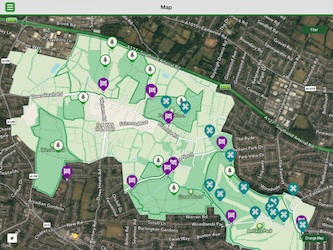Audio Trails was originally established to bring countryside and heritage sites to life and to enhance visitor experiences with the use of engaging digital interpretation solutions.
In 2005 Audio Trails produced the first downloadable MP3 audio guides in the UK and has since established itself as one of the leading digital heritage interpretation consultancies in the UK.
Dan Boys, Audio Trails’ Creative Director, talks to Advisor about how he started his career as a volunteer and later became a warden with the Peak District National Parks Authority, interpreting sites for visitors.
How would you describe Audio Trails?
Audio Trails has been producing innovative and cost-effective digital interpretation for heritage sites, countryside and tourist attractions since 2005.
Our primary aim is to enliven and enhance visitor experiences through the use of engaging digital interpretation solutions, tailored to the needs of the audience at each given location.
How did you get in to Heritage Interpretation?
After leaving university I volunteered for the Wildlife Trusts and National Trust, gaining employment with the latter as a Warden. Later I worked for the Peak District National Park Authority. Interpreting the sites I worked at to visitors was a key aspect of my role.

Apps and audio trails – what is the difference?
An audio trail is a purely audio-based experience – like downloading an album of music and listening to each track at a different location along a route.
An app can take any form – Apple used the slogan "There's an app for everything" – however our apps focus on location-based content that visitors to heritage sites use to enhance their visit. Rich content – text, images, video and/or audio – magically appear on screen as a visitor explores the sites. Online and offline maps help visitors orientate and navigate a site or area and our modular software can be extended with various plugins we offer i.e. image fader, photograph scrapbook, field guides.
How does changing technology drive your business? What has technology allowed you to do that you wouldn't otherwise be able to?
We use technology as the vehicle for location-based content. Our ethos from day one (in 2005) has been to use the equipment in visitor's pocket to tell the story of a site. As these devices have become more advanced we have utilised this functionality in our apps. Back in 2005 MP3 players weren't standard on phones. GPS enabled us to automatically trigger content to phones and gyroscopes and accelerometers have enabled us to deploy Augmented Reality. Bluetooth LE – iBeacons – is another area we are exploring. This opens up the possibility of triggering content inddors – something GPS cannot do effectively.

How do you work with your clients?
We do the bits they cannot or don't want to do. Some clients have e.g. very talented writers and therefore may only require an app developer. In other instances the client doesn't have the in-house skills and/or time to develop the project. In this instance we provide an holistic service.
What elements are essential to make a project effective?
Agreeing to milestones, ensuring good communication at all times, but also being flexible. Some clients haven't been involved in developing an app or audio trail before so it is important we guide them carefully through the process so they understand how it comes together.
Do you only work in outdoor environments? Could your trails be used in museums for instance?
95% of our work is outdoors, but we have just completed an app at Southwell Minster. The app doesn't use GPS (see above) but an interactive floorplan to guide visitors around the Archbishop's Palace. We are also very keen to work with people on developing an iBeacon project in an indoor environment.

Who is your audience? Do you develop apps for children/families for instance?
We have developed over 100 digital interpretation projects. These cater for a wide range of audiences, including family audiences, specialists, and general visitors. We are just about to complete an app for Abbeydale Industrial hamlet, Sheffield. This app is part of an Art Council-funded 'Access all Areas' project that aims to help people with a range of physical impairments to access the site. For example the app contains subtitles videos with fly-throughs of non-accessible locations – 18th century buildings didn't always take into account the needs of e.g. wheelchair users!
One of our apps was a location-based butterfly catching game at Aberbargoed Grasslands, Caerphilly. This uses Augmented Reality to help children learn about the habits and habitats of a wide range of butterflies that visit the nature reserve.
In addition to audio trails and apps we also have a dedicated Teacher and Education & Learning Co-ordinator. Ruth works with clients to develop formal and informal learning activities. The Gower app we will soon be launching has special activities for visiting schools to undertake.
A number of our digital projects e.g. Old Glossop Heritage Trail are also complemented with family activity sheets. We also design and supply interpretation panels.
For more information visit www.audiotrails.co.uk
Case Studies are available at www.audiotrails.co.uk/case studies.
Back to top




